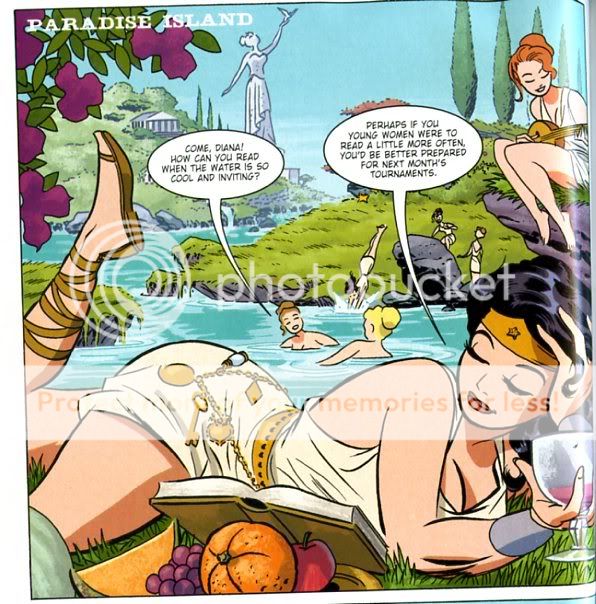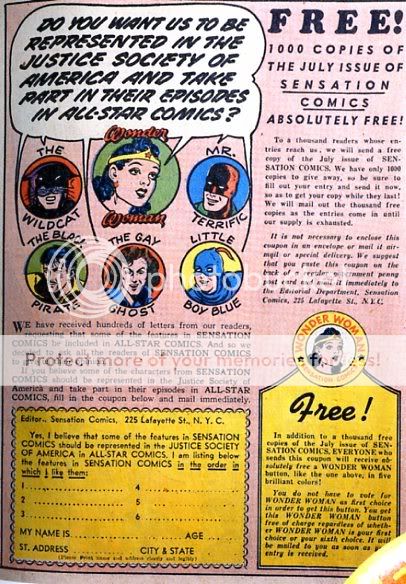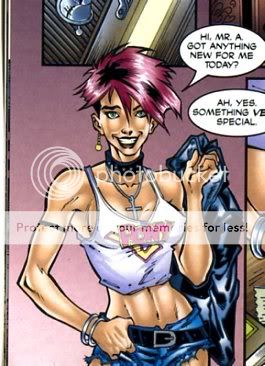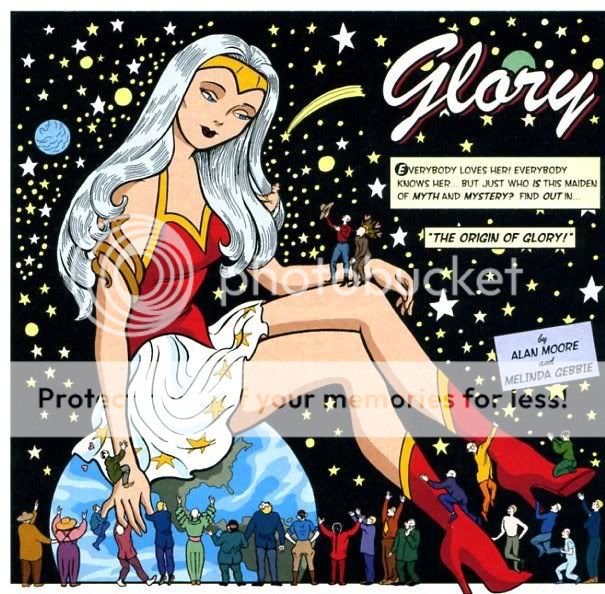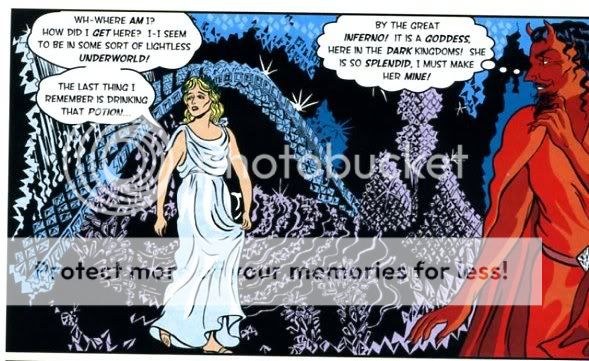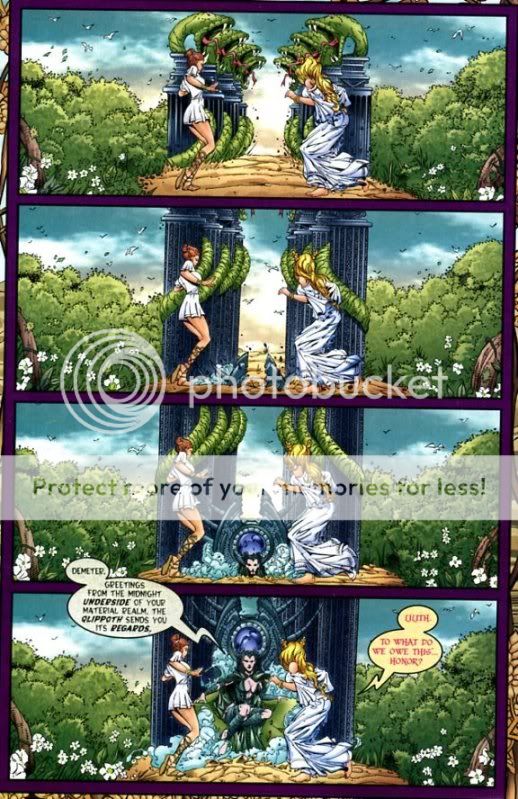This is the latest in a series of posts about post-Marston iterations of Wonder Woman. For those of you waiting for me to continue my blogging through the original Wonder Woman series; my apologies for the delay. I promise I will get back to it next week.
________________________________
I dumped on Darwyn Cooke’s mediocre New Frontier yesterday, and I’ll stand by that. I do like his art, though; nice color palette, and he combines the cartoony TV show style with a tactile realism that’s really charming. I like the way Superman and Flash’s costumes are a little baggy, for example.
I also quite like his Wonder Woman drawings. He very cleverly finds lots of excuses to get her out of the swimsuit, and he also draws her in a zaftig cheesecake pin-up style that’s hard to resist. This panel is positively luscious.
Cooke’s obviously quite plugged into Marston’s lesbian fantasy dreaming there, with tongue all the way in cheek (if that is the metaphor I want.) His characterization of WW is fairly enjoyable too; there’s one sequence where he has her free a bunch of Vietnamese women from their captors, allows them to butcher the villains, and then leads them in celebration. It’s true that this is a rather tasteless effort to gin up meaningfulness by piggybacking on Important World Tragedy –but if you can get past that, you have to admit that it’s a pretty entertaining twist on Marston’s bondage fetish. I also enjoyed seeing WW all bloodthirsty and cheerful about it, rather than earnest and dour as she is so often portrayed. Instead, it’s Superman who has to be all boring; he’s the stuffed shirt appalled at the butchery, while WW gets to be the loose canon (“I’m over here winning the hearts and minds of the disenfranchised,” she tells him confidentially).
There is a problem, though. WW does get to be the wise free spirit, a la Wolverine. But she gets to be so only in relation to that stuffed-shirt, Superman. WW hardly has a scene in the whole comic that doesn’t also feature Superman, and her function is essentially to serve as a muse for his conflict/self-actualization. Yes, she is supposed to have come to some sort of understanding about American policy herself, I guess…but Cooke cuts her off, literally in mid-sentence, before she can articulate it. But that’s okay, because her own thinking isn’t really all that important. She’s beautiful and smart and thoughtful and adventurous and daring…and all of that is in the service of getting Superman to realize that he’s the symbolic icon of wonderfulness who must lead America to greatness. That scene in south asia is thematically staged for Superman’s benefit. So, I think, is the lesbian daydream in the image above. We see WW and her Amazon sisters frolicking…and then one of them gasps “It’s a man!” and we see Superman fly in, and Diana tells him “Come fly with me, Kal,” and if that isn’t enough of a come on, she then goes on to tell him how wonderful his values are. Yay! Later she gives him a kiss and that inspires him to assume the leadership role that he’s fated for because he’s…Superman!
This is hardly the first time this has happened, of course. In these massive crossover alternate universe things, WW is always getting relegated to the helpmate/soulmate/lead you to your destiny role in support of Superman and/or Batman. It happens in DKII, and seems to more or less be a theme in Kingdom Come as well (I’ve only skimmed that.) Darwyn Cooke uses it himself in other stories. League of One is kind of the exception which proves the rule; there, WW takes up all the oxygen, and everyone else (especially Superman) is just a nonentity revolving around her psychodrama. Basically, it just seems very hard for people to figure out a way to have Supes and WW exist in the same space without treating one of them as an appendage.
Which makes sense, since, basically, they’re the same character. I mean, of course, all superheroes are based on Superman to some degree, but Wonder Woman was deliberately designed not just to riff on the superhero idea, but to actually function, narratively and psychologically the way Superman does. Marston said this himself; he was basically creating a female Superman. Now, making Superman female meant a number of very specific things to Marston (more bondage for example), and WW is different than Superman in a lot of ways. But she’s the same in that her point is really to be a paragon; the quintessence of heroism. She’s not like the Flash who’s just superfast, or Batman who’s just smart and resourceful, or even Green Lantern, who has a defined power. She’s everything to everybody. She’s superfast, she’s got superstrength, she’s superwise, and she’s just the best at everything she does. That’s the character; that’s what her stories are about.
So when you put her in a story with Superman…well, one of them has to lose focus. If it was Marston, of course, that one would be Superman, and it would be all about how men, even superman, have to submit to women, and love their submission, and so forth. But, alas, Marston’s dead, and what we get instead is the much more conventional idea that women (even wonder women) are mostly there to serve as supportive figures in male psychodrama.
It’s too bad, too, because, as I said, I think Cooke likes the character, and has some good ideas for her, and overall could probably write a decent story about her if he wasn’t so desperate to use her to shore up Superman’s ego (or Batman’s, I guess.) I shudder to read Trinity, though. I can see that being quite, quite bad.
Update: Richard points out in comments that Darwyn Cooke did not, in fact, have anything to do with the Trinity series. So maybe I should check it out after all. Or, then again, probably not.

